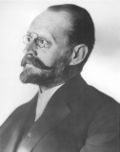Neodymium
Neodymium
Neodymium is a chemical element with the symbol Nd and atomic number 60. It is a soft, silvery metal that tarnishes in air. Neodymium is a member of the lanthanide series and is considered one of the rare earth elements.
Properties[edit]
Neodymium is a ductile and malleable metal. It is relatively reactive and quickly oxidizes in air, forming a pink or purple oxide layer. Neodymium has a high magnetic strength and is used in the production of powerful permanent magnets.
Applications[edit]
Magnets[edit]
Neodymium magnets, also known as NdFeB magnets, are the strongest type of permanent magnets available. They are widely used in various applications, including:
Glass and Ceramics[edit]
Neodymium is used to color glass and ceramics. It produces a range of colors from pink to purple, depending on the lighting conditions. Neodymium-doped glass is used in lasers and other optical applications.
Other Uses[edit]
Neodymium is also used in:
- Catalysts for petroleum refining
- Lighting applications
- Wind turbines
Health Effects[edit]
Neodymium is not known to be essential for any biological processes in humans. However, exposure to neodymium dust or fumes can pose health risks. Inhalation of neodymium compounds can cause lung damage and other respiratory issues.
Safety Precautions[edit]
When handling neodymium, it is important to use appropriate safety measures to prevent exposure. This includes using protective equipment and ensuring proper ventilation in work areas.
Environmental Impact[edit]
The mining and processing of neodymium can have significant environmental impacts. These include habitat destruction, water pollution, and the generation of hazardous waste. Efforts are being made to develop more sustainable methods of neodymium extraction and processing.
See Also[edit]
Chemical element with atomic number (Nd)
Neodymium, 00Nd
Neodymium[edit]
-
Neodymium(III) sulfate
-
Neodymium(III) acetate
-
Neodymium(III) hydroxide
-
Neodymium
-
Neodymium fluorescent
-
Neodymium daylight
-
Auer von Welsbach
-
Bastnaesite - Kischtimsk, Ural
-
Elemental abundances
-
Monazite acid cracking process
-
Neodymag
-
Neodymium glass light bulb under fluorescent and incandescent light
Ad. Transform your life with W8MD's Budget GLP-1 injections from $75


W8MD offers a medical weight loss program to lose weight in Philadelphia. Our physician-supervised medical weight loss provides:
- Weight loss injections in NYC (generic and brand names):
- Zepbound / Mounjaro, Wegovy / Ozempic, Saxenda
- Most insurances accepted or discounted self-pay rates. We will obtain insurance prior authorizations if needed.
- Generic GLP1 weight loss injections from $75 for the starting dose.
- Also offer prescription weight loss medications including Phentermine, Qsymia, Diethylpropion, Contrave etc.
NYC weight loss doctor appointmentsNYC weight loss doctor appointments
Start your NYC weight loss journey today at our NYC medical weight loss and Philadelphia medical weight loss clinics.
- Call 718-946-5500 to lose weight in NYC or for medical weight loss in Philadelphia 215-676-2334.
- Tags:NYC medical weight loss, Philadelphia lose weight Zepbound NYC, Budget GLP1 weight loss injections, Wegovy Philadelphia, Wegovy NYC, Philadelphia medical weight loss, Brookly weight loss and Wegovy NYC
|
WikiMD's Wellness Encyclopedia |
| Let Food Be Thy Medicine Medicine Thy Food - Hippocrates |
Medical Disclaimer: WikiMD is not a substitute for professional medical advice. The information on WikiMD is provided as an information resource only, may be incorrect, outdated or misleading, and is not to be used or relied on for any diagnostic or treatment purposes. Please consult your health care provider before making any healthcare decisions or for guidance about a specific medical condition. WikiMD expressly disclaims responsibility, and shall have no liability, for any damages, loss, injury, or liability whatsoever suffered as a result of your reliance on the information contained in this site. By visiting this site you agree to the foregoing terms and conditions, which may from time to time be changed or supplemented by WikiMD. If you do not agree to the foregoing terms and conditions, you should not enter or use this site. See full disclaimer.
Credits:Most images are courtesy of Wikimedia commons, and templates, categories Wikipedia, licensed under CC BY SA or similar.
Translate this page: - East Asian
中文,
日本,
한국어,
South Asian
हिन्दी,
தமிழ்,
తెలుగు,
Urdu,
ಕನ್ನಡ,
Southeast Asian
Indonesian,
Vietnamese,
Thai,
မြန်မာဘာသာ,
বাংলা
European
español,
Deutsch,
français,
Greek,
português do Brasil,
polski,
română,
русский,
Nederlands,
norsk,
svenska,
suomi,
Italian
Middle Eastern & African
عربى,
Turkish,
Persian,
Hebrew,
Afrikaans,
isiZulu,
Kiswahili,
Other
Bulgarian,
Hungarian,
Czech,
Swedish,
മലയാളം,
मराठी,
ਪੰਜਾਬੀ,
ગુજરાતી,
Portuguese,
Ukrainian










